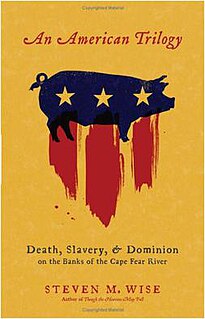 W
WAn American Trilogy: Death, Slavery, and Dominion on the Banks of the Cape Fear River is a 2009 is a non-fiction work by Steven M. Wise about the pig industry in North Carolina. Wise is an American legal scholar who specializes in animal protection.
 W
WAn animal product is any material derived from the body of an animal. Examples are fat, flesh, blood, milk, eggs, and lesser known products, such as isinglass and rennet.
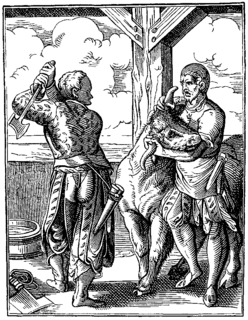 W
WAnimal slaughter is the killing of animals, usually referring to killing domestic livestock. It is estimated that each year 77 billion land animals are slaughtered for food. In general, the animals would be killed for food; however, they might also be slaughtered for other reasons such as being diseased and unsuitable for consumption. The slaughter involves some initial cutting, opening the major body cavities to remove the entrails and offal but usually leaving the carcass in one piece. Such dressing can be done by hunters in the field or in a slaughterhouse. Later, the carcass is usually butchered into smaller cuts.
 W
WAntibiotic use in livestock is the use of antibiotics for any purpose in the husbandry of livestock, which includes treatment when ill (therapeutic), treatment of a group of animals when at least one is diagnosed with clinical infection (metaphylaxis), and preventative treatment (prophylaxis). Antibiotics are an important tool to treat animal as well as human disease, safeguard animal health and welfare, and support food safety. However, used irresponsibly, this may lead to antibiotic resistance which may impact human, animal and environmental health.
 W
WApikoğlu Brothers is a family owned and operated meat packing organization founded in Turkey. The company is renowned for its production of sujuk and pastirma. Apikoğlu is the first company to mass-produce meat products in Turkey and serve the demand of its entire national market.
 W
WBacon and Hams is a 1917 book by George J. Nicholls, a member of the Institute of Certificated Grocers. The book details the then-modern bacon and ham industry beginning with the use of the pig breeds, meat processing and the distribution and pricing of cuts with a focus on the United Kingdom. The meat processing aspects focus on the popular Wiltshire cut of the time, but also includes American cuts as well. The book was described, with approbation, by the Saskatchewan Overseas Livestock Marketing Commission, as an "admirable and important treatise". Despite having entered the public domain, the book is rare and collectible and generated interest for its "unparalleled" anatomical details of pigs found in its fold-out pages.
 W
WA butcher is a person who may slaughter animals, dress their flesh, sell their meat, or participate within any combination of these three tasks. They may prepare standard cuts of meat and poultry for sale in retail or wholesale food establishments. A butcher may be employed by supermarkets, grocery stores, butcher shops and fish markets, slaughter houses, or may be self-employed.
 W
WA butcher block or butcher's block is a heavy duty chopping block, typically laminated of hardwood.
 W
WA captive bolt is a device used for stunning animals prior to slaughter.
 W
WSausage casing, also known as sausage skin or simply casing, is the material that encloses the filling of a sausage. Natural casings are made from animal intestines or skin; artificial casings, introduced in the early 20th century, are made of collagen and cellulose. The material is then shaped via a continuous extrusion process – producing a single sausage casing of indefinite length – which is then cut into desired lengths, usually while the extrusion process continues.
 W
WCattle slaughter, especially cow slaughter, is a controversial topic in India because of cattle's traditional status as an endeared and respected living being to adherents of Hinduism, Sikhism, Jainism, Buddhism, and Parsiism while being considered an acceptable source of meat by Muslims and Christians as well as adherents of other non-Dharmic Religions in India, such as the Animists and Irani Zoroastrians. More specifically, the cow's slaughter has been shunned because of a number of reasons such as being associated with god Krishna in Hinduism, cattle being respected as an integral part of rural livelihoods and an economic necessity. Cattle slaughter has also been opposed by various Indian religions because of the ethical principle of Ahimsa (non-violence) and the belief in the unity of all life. Legislation against cattle slaughter is in place throughout most states of India except Kerala, Goa, West Bengal, and states of Northeast India.
 W
WA checkweigher is an automatic or manual machine for checking the weight of packaged commodities. It is normally found at the offgoing end of a production process and is used to ensure that the weight of a pack of the commodity is within specified limits. Any packs that are outside the tolerance are taken out of line automatically.
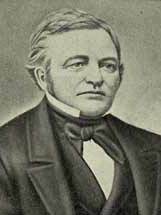 W
WThomas Dyer served as mayor of Chicago, Illinois (1856–1857) for the Democratic Party. He also served as the founding president of the Chicago Board of Trade.
 W
WEuropean Convention for the Protection of Animals during International Transport refers to two animal welfare treaties regarding livestock transportation of the Council of Europe:CETS No.65: The original convention was adopted by the Council of Europe on 13 December 1968 in Paris, and went into effect on 20 February 1971. CETS No.193: The revised convention, with "(Revised)" in the title, was adopted by the Council of Europe on 6 November 2003 in Chișinău, and went into effect on 14 March 2006. It intends to replace the original 1968 animal transport convention, and requires Parties of the 1968 convention to denounce it before ratifying the 2003 convention. Until they denounce it, the 1968 convention remains into effect for the Parties who ratified it.
 W
WThe European Convention for the Protection of Animals for Slaughter, also known as the Slaughter Convention, is an animal welfare treaty of the Council of Europe, adopted on 10 May 1979 in Strasbourg, and effective since 11 June 1982. It establishes ethical standards pertaining to animal slaughter, such as stunning.
 W
WFarmageddon: The True Cost of Cheap Meat is a 2014 non-fiction book by Philip Lymbery and Isabel Oakeshott. It surveys the effects of industrial livestock production and industrial fish farming around the world. The book is the result of Lymbery's investigations for which he travelled the world over three years. Isabel Oakeshott is the political editor of The Sunday Times, Philip Lymbery is CEO of Compassion in World Farming. The book was published by Bloomsbury.
 W
WA feedlot or feed yard is a type of animal feeding operation (AFO) which is used in intensive animal farming, notably beef cattle, but also swine, horses, sheep, turkeys, chickens or ducks, prior to slaughter. Large beef feedlots are called concentrated animal feeding operations (CAFO) in the United States and intensive livestock operations (ILOs) or confined feeding operations (CFO) in Canada. They may contain thousands of animals in an array of pens.
 W
WField dressing is the process of removing the internal organs of hunted game, and is a necessary step in obtaining and preserving meat from animals harvested in the wild. Field dressing must be done as soon as possible after killing the animal in order to ensure rapid body heat loss and prevent bacteria from growing on the surface of the carcass. Field dressing helps maintain the overall quality of the meat. It also makes it considerably easier for a hunter to carry larger game from the hunt area.
 W
WFish meal is a commercial product mostly made from fish that are not used for human consumption; fishmeal is generally used to feed farm animals in an agricultural setting, e.g., pigs, poultry, and farmed fish. Because it is calorically dense and cheap to produce, fishmeal has played a critical role in the growth of factory farms and the number of farm animals it is possible to breed and feed.
 W
WGround meat, called mince or minced meat outside North America, and keema or qeema in the Indian subcontinent, is meat finely chopped by a meat grinder or a chopping knife. A common type of ground meat is ground beef, but many other types of meats are prepared in a similar fashion, including pork, veal, lamb, and poultry. In the Indian subcontinent, both lamb and goat meat are also minced to produce keema. The term is derived from Chaghatai Turkic 'قیمه'.
 W
WA hot link is a type of sausage used in the cuisine of the Southern United States, and a part of American barbecue, soul food, and Cajun and Louisiana Creole cuisines. It is also a part of Texan cuisine and the cuisine of Chicago, Illinois. The hot link is usually prepared using pork, beef, or a combination of both. It is sometimes used as an ingredient in other dishes, such as jambalaya and gumbo. Hot link sausages are mass-produced by some companies in the United States.
 W
WIntensive animal farming or industrial livestock production, also known by its opponents as factory farming, is a type of intensive agriculture, specifically an approach to animal husbandry designed to maximize production, while minimizing costs. To achieve this, agribusinesses keep livestock such as cattle, poultry, and fish at high stocking densities, at large scale, and using modern machinery, biotechnology, and global trade. The main products of this industry are meat, milk and eggs for human consumption. There are issues regarding whether intensive animal farming is sustainable or ethical.
 W
WIntensive pig farming, also known as pig factory farming, is the primary method of pig production, in which grower pigs are housed indoors in group-housing or straw-lined sheds, whilst pregnant sows are housed in gestation crates or pens and give birth in farrowing crates.
 W
WThis is a list of countries by meat consumption. Meat is animal flesh that is eaten as food.
 W
WLive export is the commercial transport of livestock across national borders. The trade involves a number of countries with the Australian live export industry being one of the largest exporters in the global trade. According to the Australian Bureau of Statistics, exports of live sheep rose 21.4% and live calves increased 9.7% between March 2017 and March 2018. During 2017 alone, Australia exported 2.85 million living animals in shipping containers and airplanes. The expansion of the trade has been supported by the introduction of purpose-built ships which carry large numbers of animals. The amount of livestock exported from the European Union grew to nearly 586m kilograms between 2014 and 2017, a 62.5% increase during the time period.
 W
WLivestock are the domesticated animals raised in an agricultural setting to produce labor and commodities such as meat, eggs, milk, fur, leather, and wool. The term is sometimes used to refer solely to those that are bred for consumption, while other times it refers only to farmed ruminants, such as cattle, sheep and goats. Horses are considered livestock in the United States. The USDA classifies pork, veal, beef, and lamb (mutton) as livestock and all livestock as red meat. Poultry and fish are not included in the category.
 W
WMeat is animal flesh that is eaten as food. Humans have hunted and killed animals for meat since prehistoric times. The advent of civilization allowed the domestication of animals such as chickens, sheep, rabbits, pigs and cattle. This eventually led to their use in meat production on an industrial scale with the aid of slaughterhouses.
 W
WMeat and bone meal (MBM) is a product of the rendering industry. It is typically about 48–52% protein, 33–35% ash, 8–12% fat, and 4–7% water. It is primarily used in the formulation of animal feed to improve the amino acid profile of the feed. Feeding of MBM to cattle is thought to have been responsible for the spread of BSE ; therefore, in most parts of the world, MBM is no longer allowed in feed for ruminant animals. However, it is still used to feed monogastric animals.
 W
WMeat Atlas is an annual report, published by the Heinrich Böll Foundation and Friends of the Earth Europe, on the methods and impact of industrial animal agriculture and the meat industry. Barbara Unmuessig, the foundation's president, said that the report's goal is to inform consumers about the consequences of increasingly industrialized meat production.
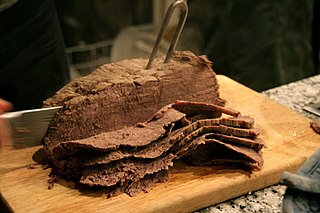 W
WMeat carving is the process and skill of cutting portions of meat, such as roast and poultry, to obtain a maximum or satisfactory number of meat portions, using a carving knife or meat-slicing machine. A meat carver disjoints the meat and slices in uniform portions. Meat carving is sometimes considered a skill for the private dinner table.
 W
WA meat cutter prepares primal cuts into a variety of smaller cuts intended for sale in a retail environment. The duties of a meat cutter largely overlap those of the butcher, but butchers tend to specialize in pre-sale processing, whereas meat cutters further cut and process the primal cuts per individual customer request.
 W
WMeat inspection is a crucial part of food safety measures and encompasses all measures directed towards the prevention of raw and processed meat spoilage. Relevant regulations include:Federal Meat Inspection Act Wholesome Meat Act
 W
WMechanically separated meat (MSM), mechanically recovered/reclaimed meat (MRM), or mechanically deboned meat (MDM) is a paste-like meat product produced by forcing pureed or ground beef, pork, mutton, turkey or chicken, under high pressure through a sieve or similar device to separate the bone from the edible meat tissue. It is sometimes called white slime as an analog to meat-additive pink slime and to meat extracted by advanced meat recovery systems, both of which are different processes. The process entails pureeing or grinding the carcass left after the manual removal of meat from the bones and then forcing the slurry through a sieve under pressure. This puree includes bone, bone marrow, skin, nerves, blood vessels, and the scraps of meat remaining on the bones. The resulting product is a blend primarily consisting of tissues not generally considered meat along with a much smaller amount of actual meat. In some countries such as the United States, these non-meat materials are processed separately for human and non-human uses and consumption. The process is controversial; Forbes, for example, called it a "not-so-appetizing meat production process".
 W
WModern Meat: Antibiotics, Hormones, and the Pharmaceutical Farm is a 1984 book by Orville Schell on intensive animal farming and antibiotic use in livestock.
 W
WO'Sullivan v Noarlunga Meat Ltd, was a case decided in the High Court of Australia regarding the scope of the trade and commerce power, under s 51(i) of the Australian Constitution, and inconsistency between Commonwealth and State laws, under section 109 of the Constitution.
 W
WO'Sullivan v Noarlunga Meat Ltd , was a High Court of Australia case, in which a certificate, under s 74 of the Australian Constitution, was sought for leave to appeal to the Privy Council against the previous decision of O'Sullivan v Noarlunga Meat Ltd.
 W
WA pig scalder is a tool that was used to soften the skin of a pig after it had been killed to remove the hair from its skin. Because people rarely slaughter and process their own pigs anymore, pig scalders are seldom used for domestic use.
 W
WPig slaughter is the work of slaughtering domestic pigs which is both a common economic activity as well as a traditional feast in some European and Asian countries.
 W
WPink slime is a meat by-product used as a food additive to ground beef and beef-based processed meats, as a filler, or to reduce the overall fat content of ground beef. As part of the production process, heat and centrifuges remove the fat from the meat in beef trimmings. The resulting paste, without the fat, is exposed to ammonia gas or citric acid to kill bacteria. In 2001, the United States Department of Agriculture (USDA) approved the product for limited human consumption. The product, when prepared using ammonia gas, is banned for human consumption in the European Union.
 W
WRendering is a process that converts waste animal tissue into stable, usable materials. Rendering can refer to any processing of animal products into more useful materials, or, more narrowly, to the rendering of whole animal fatty tissue into purified fats like lard or tallow. Rendering can be carried out on an industrial, farm, or kitchen scale. It can also be applied to non-animal products that are rendered down to pulp.
 W
WRodent farming is an agricultural process in which rodents are bred and raised with the intent of selling them for their meat. They are often categorised in a sub-category of livestock known as micro-livestock, due to their small size. Rodents have been used as food in a wide range of cultures, including Hawaiian, Vietnamese, French, Indian and Thai.
 W
WSaladero is a basic industry that produces salted meat such as charqui. It was one of the earliest industries of Argentina and Uruguay after the Argentine War of Independence, benefiting from the availability of cattle in the Humid Pampas and the low technology and manpower requirements. Most of the production was sold to Cuba and Brazil to feed slaves. In time, it expanded into other areas, such as extracting the leather, horns and fat from cows. Saladero declined at the end of the 19th century, with the lowering numbers of foreign slaves and the expansion of refrigeration techniques.
 W
WA sausage is a type of meat product usually made from ground meat, often pork, beef, or poultry, along with salt, spices and other flavourings. Other ingredients such as grains or breadcrumbs may be included as fillers or extenders.
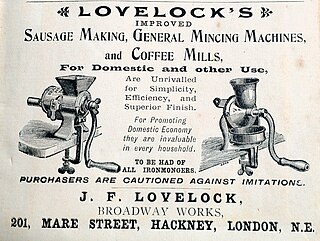 W
WThe origins of meat preservation are lost to the ages but probably began when humans began to realize the preservative value of salt. Sausage making originally developed as a means to preserve and transport meat. Primitive societies learned that dried berries and spices could be added to dried meat. The procedure of stuffing meat into casings remains basically the same today, but sausage recipes have been greatly refined and sausage making has become a highly respected culinary art.
 W
WScalding is a form of thermal burn resulting from heated fluids such as boiling water or steam. Most scalds are considered first- or second-degree burns, but third-degree burns can result, especially with prolonged contact. The term is from the Latin word calidus, meaning hot.
 W
WA slaughterhouse, also called abattoir, is a facility where animals are slaughtered, most often to provide food for humans. Slaughterhouses supply meat, which then becomes the responsibility of a packaging facility.
 W
WA smokehouse or smokery (British) is a building where meat or fish is cured with smoke. The finished product might be stored in the building, sometimes for a year or more. Even when smoke is not used, such a building—typically a subsidiary building—is sometimes referred to as a "smokehouse". When smoke is not used, the term "meat house" is common.
 W
WStunning is the process of rendering animals immobile or unconscious, with or without killing the animal, when or immediately prior to slaughtering them for food.
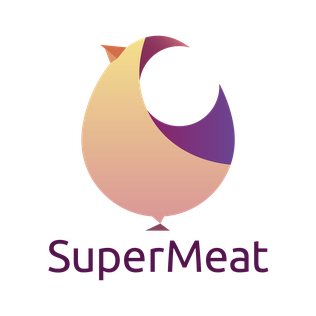 W
WSuperMeat is an Israeli startup company working to develop a "meal-ready" chicken cultured meat product created through the use of cell culture. The company, which is crowdfunded through Indiegogo, claims that their product is more environmentally sound than conventional meat production as well as more economic, and involves no animal slaughter.
 W
WWildlife farming refers to the raising of traditionally undomesticated animals in an agricultural setting to produce: living animals for canned hunting and to be kept as pets; commodities such as food and traditional medicine; and materials like leather, fur and fiber.